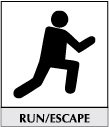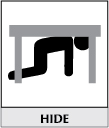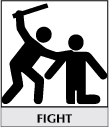An Active Shooter is an individual actively engaged in killing or attempting to kill people in a confined and populated area; in many cases, active shooters use firearms and there is no pattern or method to their selection of victims.
These situations are unpredictable and evolve quickly. Typically, the immediate deployment of law enforcement is required to stop the shooting and mitigate harm to victims. Because active shooter situations are often over within 10 to 15 minutes and, before law enforcement arrives on the scene, individuals must be prepared both mentally and physically to deal with an active shooter situation.
RUN, HIDE, FIGHT! Protect yourself!
RUN

If there is an accessible escape path, attempt to leave the area of danger.
-
- Have an escape route and plan in mind
- Leave the area regardless of whether others agree to follow
- Leave your belongings behind
- Help others escape, if possible, in a safe manner
- Prevent individuals from entering an area where the active shooter may be
- Keep your hands visible
- Follow the instructions of any police officers and Security
- Do not attempt to move wounded people
- Dial 911 and notify SCC when you are safe
HIDE

If you are unable to remove yourself from the area of danger, find a place to hide where the active shooter is less likely to find you.
-
- Your hiding place should:
- Be out of the active shooter’s view
- Provide protection if shots are fired in your direction (i.e., an office with a closed and locked door)
- Not trap you or restrict your options for movement
- Prevent an active shooter from entering your hiding place:
- Be able to be locked or entrance blocked with furniture
- To prevent an active shooter from entering your hiding place:
- Lock the door
- Blockade the door with heavy furniture
- Remain calm
- If the active shooter is nearby
- Lock the door
- Silence your cell phone and/or radio
- Turn off any source of noise
- Hide behind large items
- Remain quiet
- Your hiding place should:
FIGHT

Take action against the active shooter – As a last resort, and only when your life is in imminent danger, attempt to disrupt and/or incapacitate the active shooter by:
-
- Acting as aggressively as possible against him/her
- Throwing items and improvising weapons
- Yelling
- Committing to your actions
When law enforcement arrives:
-
- Law enforcement’s purpose is to stop the active shooter as quickly as possible and will proceed directly to the area where the last shots were heard.
- The first offices to arrive to the scene will not stop to help injured persons.
- Officers may:
- Wear regular patrol uniforms or external bulletproof vests, Kevlar helmets, and other tactical equipment
- Be armed with rifles, shotguns, handguns
- Use pepper spray or tear gas to control the situation
- Shout commands and/or push individuals to the ground for their safety
- Have rescue teams to treat and remove any injured persons.
- Call upon able-bodied individuals to assist in removing the wounded from the premises.
- Officers may:
How to react when law enforcement arrives:
-
- Remain calm and follow officers’ instructions
- Put down any items in your hands (i.e., bags, jackets)
- Immediately raise hands and spread fingers
- Keep hands visible at all times
- Avoid making quick movements toward officers such as holding on to them for safety
- Avoid pointing, screaming, and/or yelling
- Do not stop to ask officers for help or directions when evacuating. Proceed in the direction from which officers are entering or are telling you to go
- Once you have reached a safe location or an assembly point, do not leave until law enforcement authorities have instructed to do so.
- Expect rescue teams comprised of additional officers and emergency medical personnel to follow the initial officers. These rescue teams will treat and remove any injured persons. They may also call upon able-bodied individuals to assist in removing the wounded from the premises. The first officers to arrive to the scene will not stop to help injured persons.
Updated 9/13/24
